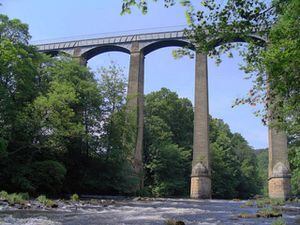Pontcysyllte Aqueduct fall tragedy: Coroner raises safety concerns over railings
A coroner has warned that signs are not enough to prevent another tragedy on the Pontcysyllte Aqueduct.

Following a conclusion of misadventure over the death of 18-year-old Kristopher McDowell, from Cefn Mawr, John Gittins, the coroner for North Wales East and Central, said he remained concerned about two aspects – the size of the gaps between the uprights and the adequacy of the monthly and annual safety checks.
It came as he published his Regulation 28 report, aimed at preventing future deaths, spelling out his concerns to the Canal and River Trust.
The trust is responsible for the 200-year-old aqueduct where Kristopher got through a gap in the railings in May 2016. As he grabbed one of the cast-iron uprights it came away and he plunged 120 feet to his death.
Expert engineers told the inquest that the trust’s maintenance and inspection protocols were good and that the structure, a UNESCO World Heritage Site, was safe if used in the proper manner.
See also:
In his report, copies of which have been sent to the Chief Coroner and to Kristopher’s family, Mr Gittins said: "The average space between the uprights on the parapet on the aqueduct is 195mm whilst the current industry standard is 110mm as a result of which there exists a risk that a person might be able to pass between them.
Risk
"This is a particular risk for children using the aqueduct but it is also a significant risk for young persons or adults, being of sufficient width for them to pass through in circumstances whereby it was their intention to gain access to the non-pedestrian side of the parapet for a purpose which would not be considered the intended use of the structure.
"In my opinion the use of signage alone, warning users of the potential risk, does not adequately mitigate the risk of a person passing through the uprights and falling from the aqueduct."
He continued: "Evidence provided by an expert instructed by the Canal and River Trust (CRT) indicated that it was his belief that the upright became detached as a result of a lifting action which disengaged the nib at the bottom of the upright from the socket on the outside of the parapet.
"The evidence provided to the inquest by engineers from CRT advised that their inspection procedures provided for an annual inspection which included testing for the extent of embedment by a push/pull test, however, in my opinion, the subjective elements of this test would permit inconsistencies in the information which it provides.
"Furthermore, exact measurements of the degree of embedment of uprights would only routinely be established in the course of a Principal Inspection which takes place every 20 years and as a result it is difficult for there to be an accurate/regular assessment of the rates of possible deterioration and hence the true extent of embedment.
“In my opinion, the testing processes currently adopted are inadequate to ensure that the uprights are properly engaged at all times."
The Trust has 56 days to respond and explain what action, if any, it has taken or proposes to take.





